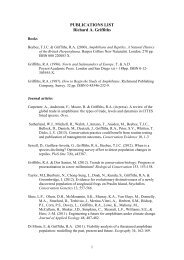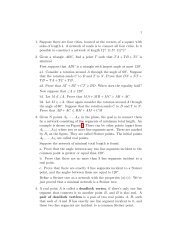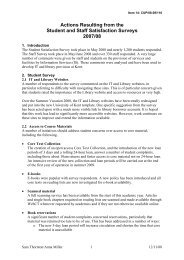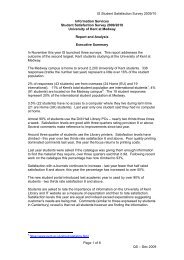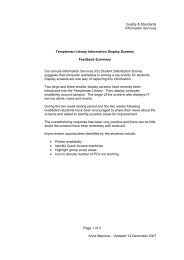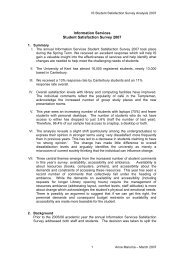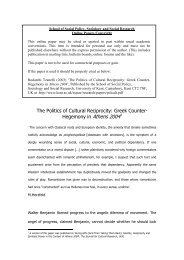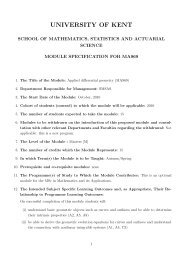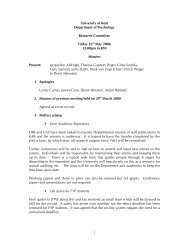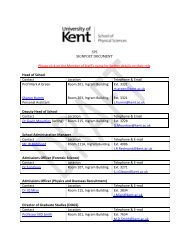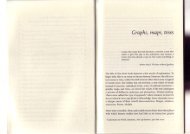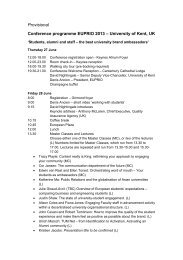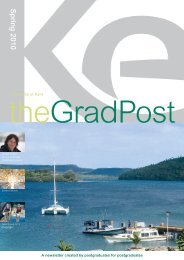Download - University of Kent
Download - University of Kent
Download - University of Kent
You also want an ePaper? Increase the reach of your titles
YUMPU automatically turns print PDFs into web optimized ePapers that Google loves.
STAFF PROFILE<br />
<strong>University</strong> <strong>of</strong> <strong>Kent</strong> / ARTS STUDIO<br />
AMANDA BEECH<br />
Pr<strong>of</strong>essor Amanda Beech is an artist and writer. Her<br />
work uses a range <strong>of</strong> media including video, sculpture,<br />
installation and drawing and she has exhibited<br />
internationally, most recently in Berlin and<br />
London’s Tate Britain. She taught at Goldsmiths and<br />
the <strong>University</strong> <strong>of</strong> the Arts in London before arriving at<br />
<strong>Kent</strong> in October 2010.<br />
When did you know you wanted<br />
to be an artist?<br />
It really never felt like a choice since<br />
I can’t imagine doing anything else.<br />
I make art, and I enjoy writing and<br />
curating as these are part <strong>of</strong> my<br />
practice and loop back into the<br />
production <strong>of</strong> art. When I was<br />
studying art, I spent most <strong>of</strong> my<br />
time painting and, even though I<br />
haven’t painted for 15 years or so,<br />
I still draw and consider most <strong>of</strong><br />
my work to be defined through<br />
producing pictures; whether the<br />
work is produced in time-based or<br />
three dimensional media. The idea<br />
<strong>of</strong> producing and working with<br />
images remains central to my work.<br />
What is the main inspiration for<br />
your own practice?<br />
I am interested in the power and<br />
force <strong>of</strong> the image as well as<br />
images <strong>of</strong> force. In particular, the<br />
question <strong>of</strong> how these forces<br />
moblise, organise and ask us to<br />
rethink what images mean and how<br />
we relate to them, is central to all my<br />
work. This work is inspired by the<br />
problems <strong>of</strong> thinking about the big<br />
themes <strong>of</strong> agency, critique, freedom<br />
and truth and how they are possible<br />
in western neoliberal democracy.<br />
Therefore, my work entangles a<br />
wide variety <strong>of</strong> research, including<br />
philosophical texts, TV shows such<br />
as CSI: Miami and film noir. I also<br />
co-direct two research groups which<br />
include academics, writers and<br />
artists and discuss current issues<br />
in art research. I enjoy testing my<br />
ideas in these kinds <strong>of</strong> environments<br />
and sharing these concerns through<br />
live discussion.<br />
What attracted you to <strong>Kent</strong>?<br />
Coming from an art college, I liked<br />
the fact that at <strong>Kent</strong> there is a wider<br />
reach <strong>of</strong> research that includes<br />
science-based and humanities<br />
programmes and this <strong>of</strong> course<br />
opens up possibilities to work<br />
across disciplines. I was also<br />
attracted by the space available:<br />
there are large studios and<br />
interesting outside spaces which are<br />
ideal for sculpture and large work.<br />
There are also lots <strong>of</strong> opportunities<br />
for the students to show their work,<br />
all <strong>of</strong> which leads to a quite<br />
progressive sense <strong>of</strong> practice.<br />
How is studying Fine Art at<br />
<strong>Kent</strong> different to studying it<br />
elsewhere?<br />
It is an exciting time to be at <strong>Kent</strong>.<br />
We are working together across<br />
Fine Art, Music, and Event and<br />
Experience Design to create a<br />
new common framework for the<br />
curriculum, allowing students from<br />
all disciplines to be taught together.<br />
Dedicated specialists will teach<br />
subject-specific skills, but, once<br />
a week, students will have the<br />
opportunity to share their<br />
experiences and discuss aspects<br />
<strong>of</strong> their work with each other.<br />
Through these joint sessions, they<br />
gain an understanding <strong>of</strong> each<br />
other’s skills and expertise which<br />
helps to accelerate their learning.<br />
The sessions will also give them<br />
the chance to make contacts with<br />
people who they may well end<br />
up working with in the future.<br />
How do students find the<br />
critiques?<br />
Understanding how criticism works<br />
is fundamental to students’ ability to<br />
be responsible to their practice.<br />
They need to understand the<br />
difference between anecdotal<br />
feelings and analysis and critical<br />
commentary, and also to understand<br />
that being critical is not a negative<br />
thing. It is a challenging environment<br />
for students – their assumptions are<br />
tested – but by the time they leave<br />
the course they understand better<br />
what shapes and informs their<br />
decisions and judgements, how<br />
they are constructed and that they<br />
are part <strong>of</strong> a wider set <strong>of</strong> cultural<br />
debates.<br />
What do you enjoy about<br />
teaching?<br />
Seeing students bring in new ideas<br />
about what art can be and inventive<br />
approaches to making art is<br />
inspiring. It is enthralling to listen to<br />
people who have a really different<br />
take on the world. All the students<br />
are different and that is what makes<br />
teaching fascinating and worthwhile.<br />
How do you see the future for<br />
your students?<br />
I think Fine Art produces graduates<br />
who are innovative, creative and<br />
analytical in their thinking. They<br />
understand what underlies the<br />
existing frameworks <strong>of</strong> society and<br />
have the imagination to see the<br />
world in different and unusual ways.<br />
It is a big claim to make for art, but I<br />
do believe that people who graduate<br />
from arts courses can change the<br />
way we think about our culture and<br />
ourselves, can change society and,<br />
hopefully, make it better. A student<br />
from <strong>Kent</strong> could produce work in<br />
ways that we might not have thought<br />
<strong>of</strong> yet – creating images that ask us<br />
to readdress our relation to society<br />
and each other. They could write<br />
new understandings <strong>of</strong> what images<br />
mean, and curate at international<br />
galleries such as the Serpentine<br />
Gallery in London, programming<br />
what the public will see for the next<br />
20 years. The promise <strong>of</strong> such<br />
innovation and pr<strong>of</strong>essionalism,<br />
as well as wielding that kind <strong>of</strong><br />
influence, is quite a remarkable<br />
thing.<br />
Amanda Beech, Sanity Assassin, three-channel video installation with sound, 2010<br />
17



